NCLEX Practice Exam 4 (50 Items) | TOP SCORE | Download To Score An A
Document Content and Description Below
NCLEX Practice Exam 4 (50 Items) The primary reason for rapid continuous rewarming of the area affected by frostbite is to: Prevent the formation of blisters Prevent pain and discomfort ... A client recently started on hemodialysis wants to know how the dialysis will take the place of his kidneys. The nurse’s response is based on the knowledge that hemodialysis works by: Eliminating plasma proteins from the blood Filtering waste through a dialyzing membrane During a home visit, a client with AIDS tells the nurse that he has been exposed to measles. Which action by the nurse is most appropriate? Contact the physician for an order for immune globulin Tell the client that he should remain in isolation for 2 weeks A client hospitalized with MRSA (methicillin-resistant staph aureus) is placed on contact precautions. Which statement is true regarding precautions for infections spread by contact? Infection requires close contact; therefore, the door may remain open. Infection requires skin-to-skin contact and is prevented by hand washing, gloves, and a gown. A client who is admitted with an above-the-knee amputation tells the nurse that his foot hurts and itches. Which response by the nurse indicates understanding of phantom limb pain? “The pain is due to peripheral nervous system interruptions. I will get you some pain medication.” “The pain and itching are due to the infection you had before the surgery.” A client with cancer of the pancreas has undergone a Whipple procedure. The nurse is aware that during the Whipple procedure, the doctor will remove the: Proximal third section of the small intestines Esophagus and jejunum The physician has ordered a minimal-bacteria diet for a client with neutropenia. The client should be taught to avoid eating: Salt Ketchup A client is discharged home with a prescription for Coumadin (sodium warfarin). The client should be instructed to: Eat more fruits and vegetables Avoid crowds The nurse is assisting the physician with removal of a central venous catheter. To facilitate removal, the nurse should instruct the client to: Turn his head to the left side and hyperextend the neck Turn his head to the right while maintaining a sniffing position A client has an order for streptokinase. Before administering the medication, the nurse should assess the client for: A history of streptococcal infections A history of alcohol abuse The nurse is providing discharge teaching for the client with leukemia. The client should be told to avoid: Flossing between the teeth Using an electric razor Question 11 Explanation: The nurse is changing the ties of the client with a tracheotomy. The safest method of changing the tracheotomy ties is to: Have a helper present. Ask the doctor to suture the tracheostomy in place. The nurse is monitoring a client following a lung resection. The hourly output from the chest tube was 300mL. The nurse should give priority to: Milking the tube to ensure patency Notifying the physician The infant is admitted to the unit with tetralogy of fallot. The nurse would anticipate an order for which medication? Epinephrine Atropine The nurse is educating the lady’s club in self-breast exam. The nurse is aware that most malignant breast masses occur in the Tail of Spence. On the diagram below, select where the Tail of Spence is. It is in B. It is in D. The toddler is admitted with a cardiac anomaly. The nurse is aware that the infant with a ventricular septal defect will: Grow normally Be more susceptible to viral infections The nurse is monitoring a client with a history of stillborn infants. The nurse is aware that a nonstress test can be ordered for this client to: Measure the fetal activity Measure the well-being of the fetus The nurse is evaluating the client who was admitted 8 hours ago for induction of labor. The following graph is noted on the monitor. Which action should be taken first by the nurse? Perform a vaginal exam Place the client in a semi-Fowler’s position The nurse notes the following on the ECG monitor. The nurse would evaluate the cardiac arrhythmia as: A sinus rhythm Atrial fibrillation A client with clotting disorder has an order to continue Lovenox (enoxaparin) injections after discharge. The nurse should teach the client that Lovenox injections should: Be injected into the abdomen Clear the air from the syringe before injections The nurse has a preop order to administer Valium (diazepam) 10mg and Phenergan (promethazine) 25mg. The correct method of administering these medications is to: Administer the medication separately Question the order because they cannot be given at the same time A client with frequent urinary tract infections asks the nurse how she can prevent the reoccurrence. The nurse should teach the client to: Void every 3 hours Wipe from back to front after voiding Which task should be assigned to the nursing assistant? Emptying the Foley catheter of the preeclamptic client Ambulating the client with a fractured hip The client has recently returned from having a thyroidectomy. The nurse should keep which of the following at the bedside? A padded tongue blade An airway The physician has ordered a histoplasmosis test for the elderly client. The nurse is aware that histoplasmosis is transmitted to humans by: Dogs Birds What’s the first intervention for a patient experiencing chest pain and an p02 of 89%? Administer oxygen Obtain an electrocardiogram (ECC) Which of the following signs and symptoms usually signifies rapid expansion and impending rupture of an abdominal aortic aneurysm? Absent pedal pulses Lower back pain In which of the following types of cardiomyopathy does cardiac output remain normal? Hypertrophic Restrictive Which of the following interventions should be your first priority when treating a patient experiencing chest pain while walking? Get the patient back to bed Administer sublingual nitroglycerin Which of the following positions would best aid breathing for a patient with acute pulmonary edema? Left side-lying position Semi-Fowler’s position A pregnant woman arrives at the emergency department (ED) with abruptio placentae at 34 weeks’ gestation. She’s at risk for which of the following blood dyscrasias? Idiopathic thrombocytopenic purpura (ITP). Heparin-associated thrombosis and thrombocytopenia (HATT). A 16-year-old patient involved in a motor vehicle accident arrives in the ED unconscious and severely hypotensive. He’s suspected to have several fractures of his pelvis and legs. Which of the following parenteral fluids is the best choice for his current condition? 0.9% sodium chloride solution. Packed red blood cells. Corticosteroids are potent suppressors of the body’s inflammatory response. Which of the following conditions or actions do they suppress? Pain receptors. Neural transmission. A patient infected with human immunodeficiency virus (HIV) begins zidovudine therapy. Which of the following statements best describes this drug’s action? It interferes with viral replication. It promotes excretion of viral antibodies. Question 34 Explanation: A 20-year-old patient is being treated for pneumonia. He has a persistent cough and complains of severe pain on coughing. What could you tell him to help him reduce his discomfort? “Place the head of your bed flat to help with coughing.” “Splint your chest wall with a pillow for comfort.” A 19-year-old patient comes to the ED with acute asthma. His respiratory rate is 44 breaths/minute, and he appears to be in acute respiratory distress. Which of the following actions should you take first? Give a bronchodilator by nebulizer. Provide emotional support for the patient. Question 37 A firefighter who was involved in extinguishing a house fire is being treated for smoke inhalation. He develops severe hypoxia 48 hours after the incident, requiring intubation and mechanical ventilation. Which of the following conditions has he most likely developed? Atelectasis. Pneumonia. Which of the following measures best determines that a patient who had a pneumothorax no longer needs a chest tube? Arterial blood gas (ABG) levels are normal. The water-seal chamber doesn’t fluctuate when no suction is applied. Which of the following nursing interventions should you use to prevent footdrop and contractures in a patient recovering from a subdural hematoma? Low-dose heparin therapy. Sequential compressive device. Which of the following signs of increased intracranial pressure (ICP) would appear first after head trauma? Large amounts of very dilute urine. Widened pulse pressure. When giving intravenous (I.V.) phenytoin, which of the following methods should you use? Withhold other anticonvulsants. Flush the I.V. catheter with dextrose solution. After surgical repair of a hip, which of the following positions is best for the patient’s legs and hips? Adduction Subluxated Which of the following factors should be the primary focus of nursing management in a patient with acute pancreatitis? Fluid and electrolyte balance. Pain control. After a liver biopsy, place the patient in which of the following positions? Right side-lying, with the bed flat. Right side-lying, with the bed in semi-Fowler’s position. Which of the following potentially serious complications could occur with therapy for hypothyroidism? Angina or cardiac arrhythmia. Thrombocytopenia. Adequate fluid replacement and vasopressin replacement are objectives of therapy for which of the following disease processes? Diabetes insipidus. Syndrome of inappropriate antidiuretic hormone secretion (SIADH). Patients with Type 1 diabetes mellitus may require which of the following changes to their daily routine during periods of infection? Less insulin. Oral diabetic agents. On a follow-up visit after having a vaginal hysterectomy, a 32-year-old patient has a decreased hematocrit level. Which of the following complications does this suggest? Hypovolemia. Pulmonary embolus (PE) A patient has partial-thickness burns to both legs and portions of his trunk. Which of the following I.V. fluids is given first? D5W. 0.9% sodium chloride solution with 2 mEq of potassium per 100 ml. Which of the following techniques is correct for obtaining a wound culture specimen from a surgical site? Use a sterile swab and wipe the crusty area around the outside of the wound. Use a sterile swab to collect drainage from the dressing. [Show More]
Last updated: 2 years ago
Preview 1 out of 25 pages
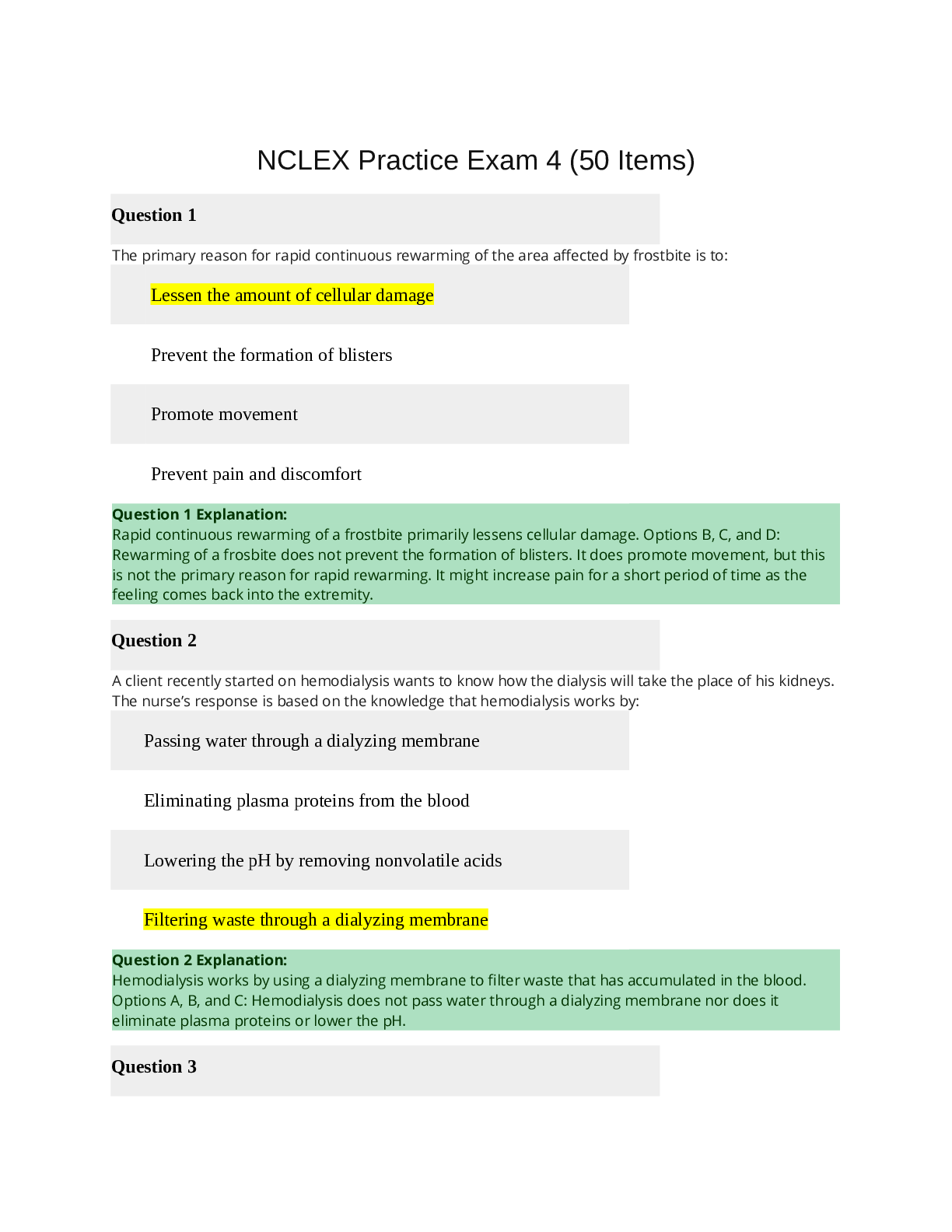
Buy this document to get the full access instantly
Instant Download Access after purchase
Buy NowInstant download
We Accept:

Reviews( 0 )
$15.00
Can't find what you want? Try our AI powered Search
Document information
Connected school, study & course
About the document
Uploaded On
May 10, 2022
Number of pages
25
Written in
Additional information
This document has been written for:
Uploaded
May 10, 2022
Downloads
0
Views
109
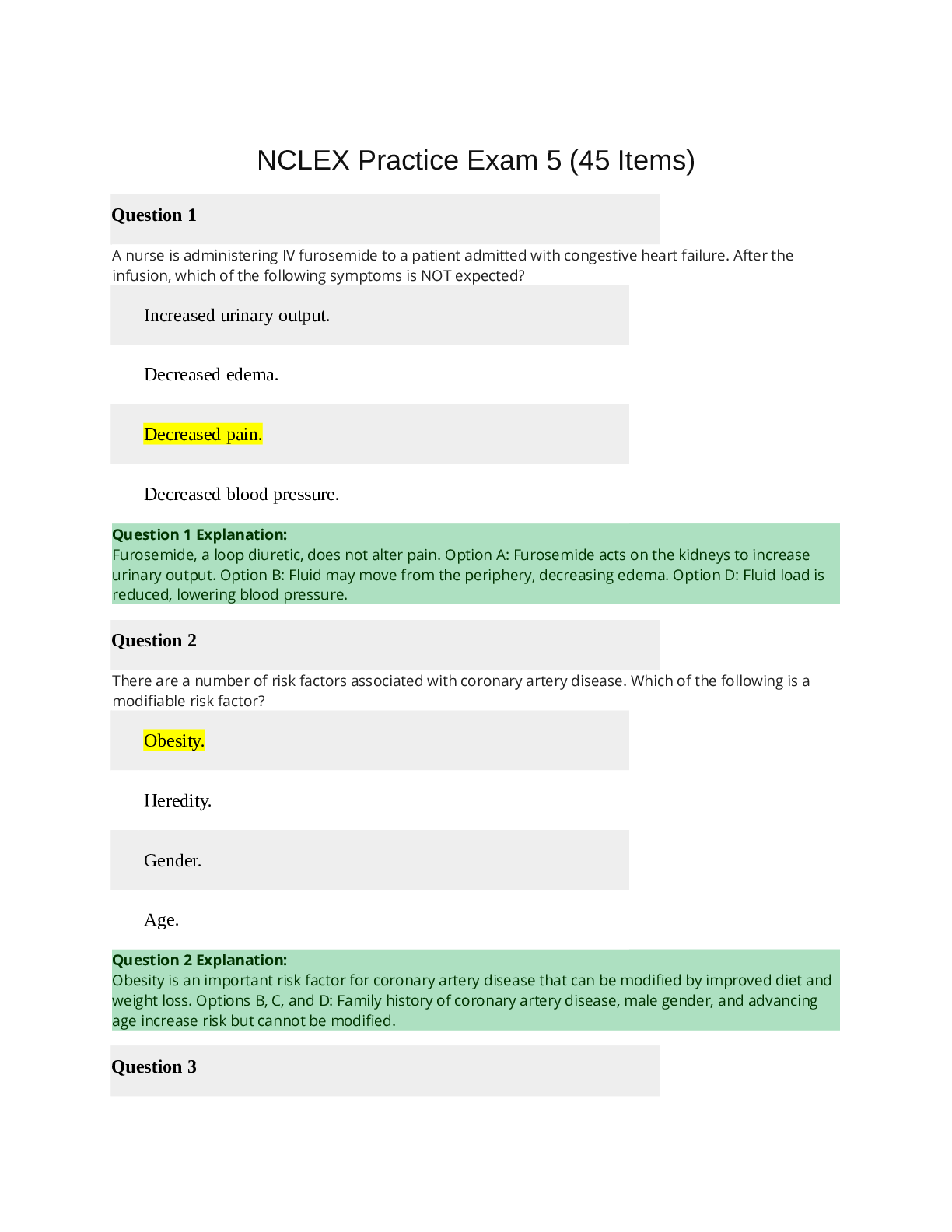

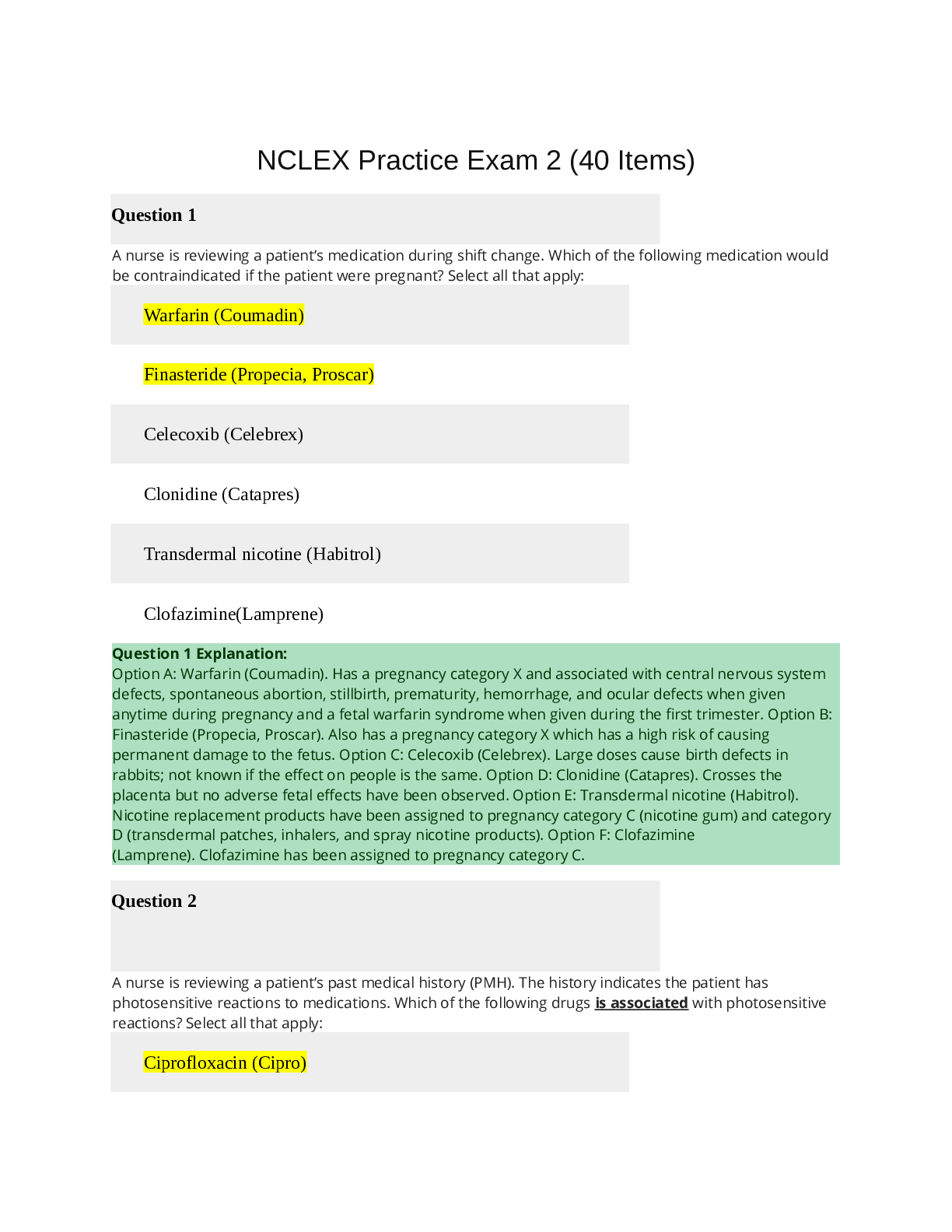



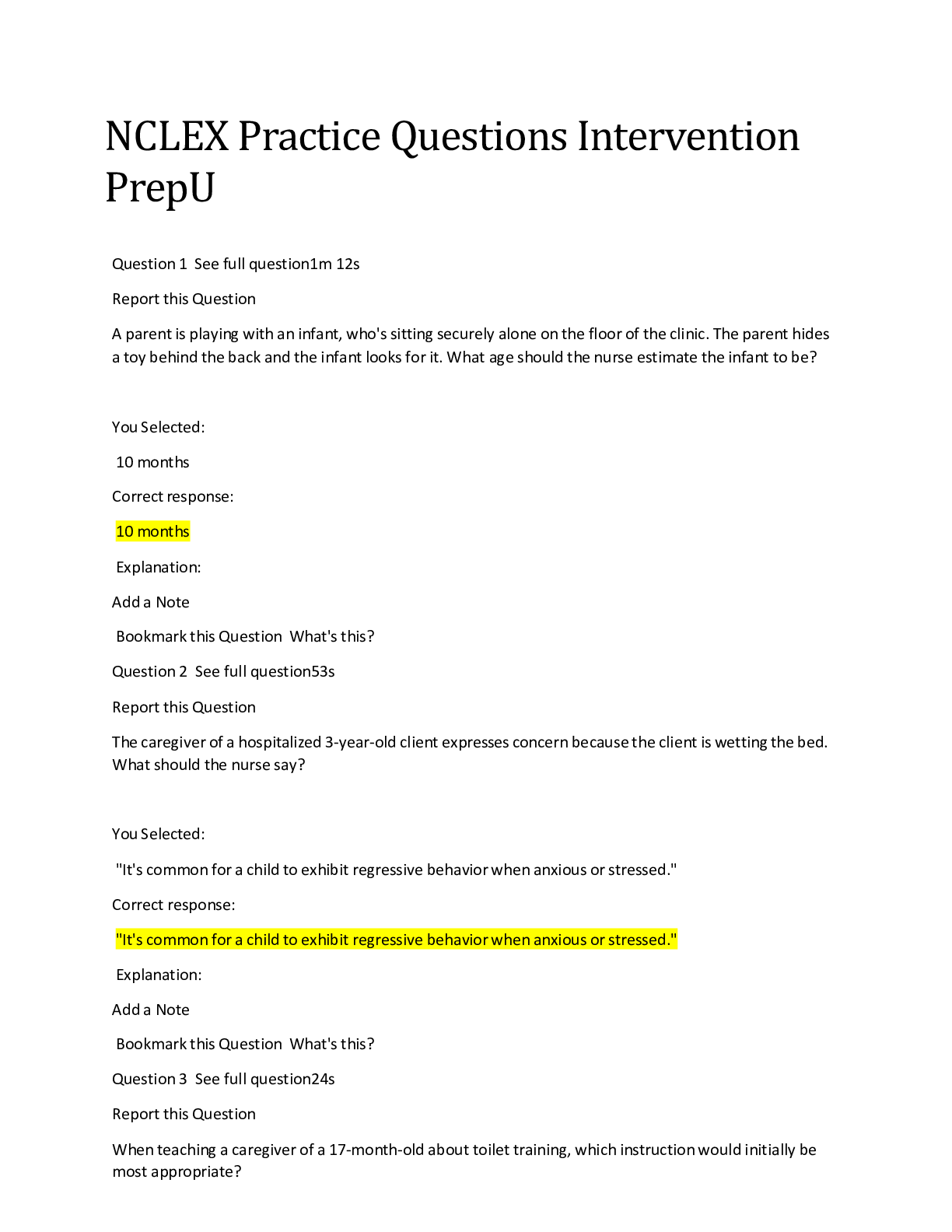
 (1).png)
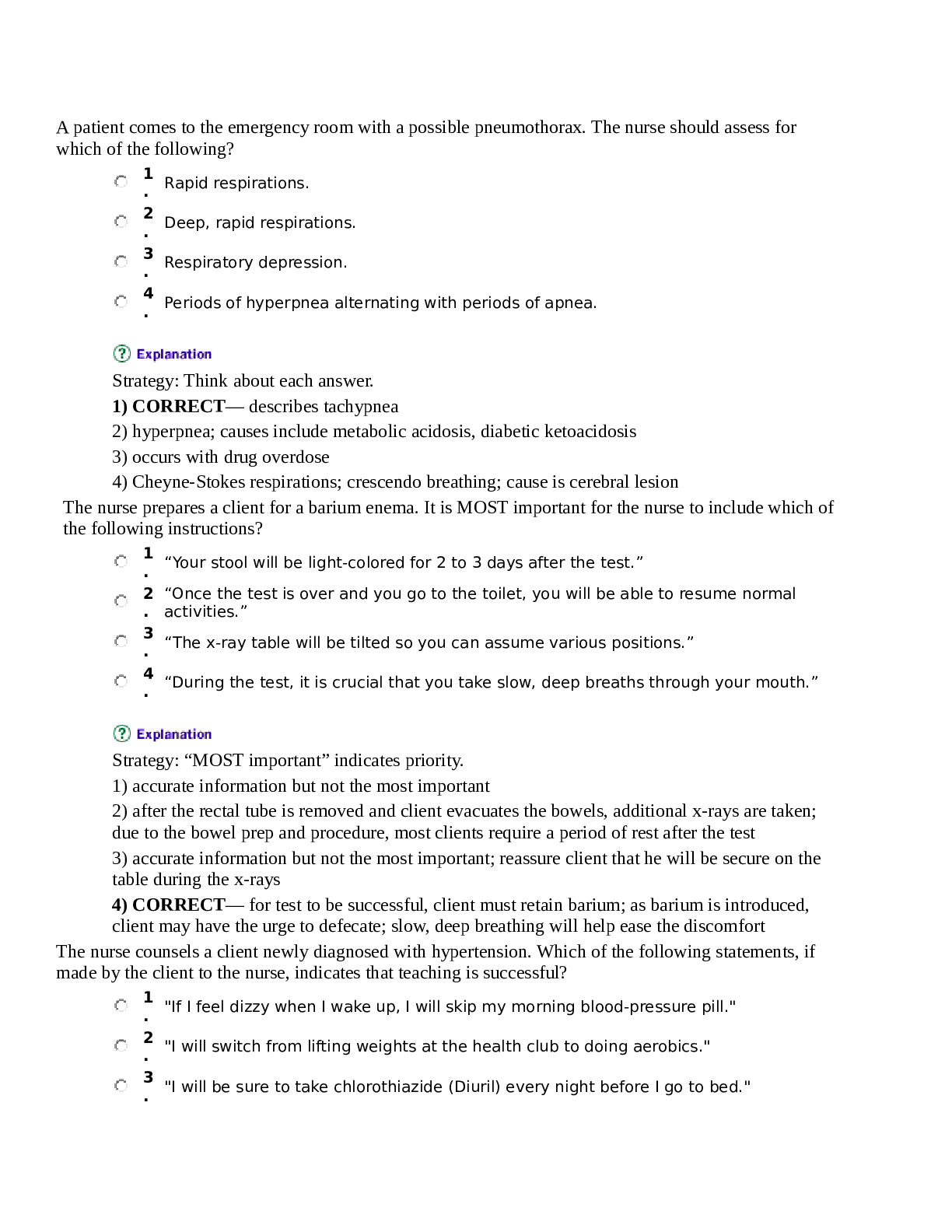



.png)


